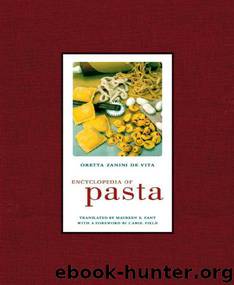Encyclopedia of Pasta by Vita Oretta Zanini De

Author:Vita Oretta Zanini De
Language: eng
Format: mobi, pdf
Published: 0101-01-01T00:00:00+00:00
The artisans of Secinaro and
Pretoro, in the provinces of
L'Aquila
and
Chieti, were
specialists in making this utensil. Its
ancestor is lu rentrocelo, which was
o n c e used around Pescara and
L'Aquila.
Today, maccheroni alla chitarra,
also
called
tonnarelli,
are
universally
associated with
Abruzzese and Molisan gastronomy
and marketed both fresh and dry.
142. MACCHERONI ALLA
PECORARA
Pasta corta
INGREDIENTS: Wheat flour, eggs,
and water.
HOW MADE: The flour is sifted
and kneaded long and strenuously
with eggs and water until a smooth,
firm dough forms. The dough is then
shaped into thin strings, which are
pressed closed in rings about 2
inches (5 cm) in diameter. The rings
are boiled in salted water.
ALSO KNOWN AS: No alternative
names.
HOW SERVED: As pastasciutta,
with mutton ragu, but also with
vegetable-based sauces, and always
with a final dusting of local
pecorino. A sauce of pancetta, eggs,
and cheese is also common.
WHERE FOUND: Abruzzo.
REMARKS: Sheep are omnipresent
in the gastronomy of Abruzzo, land
of pastures and of transhumance.
Flavorful sheep's milk cheeses are
always on hand for the pasta.
The sauce of pancetta, cheese, and
eggs was typical of the carbonai,
"charcoal workers," who stayed in
the mountains the Apennines of
central
Italy
for long periods
making charcoal. Eggs, cheese, and
pancetta kept well and could be
carried easily on mule back,
together with dry homemade pasta.
Today, this preparation, now called
alla carbonara, has circled the
globe.
143. MACCHERONI CON LU
CEPPE
Pasta lunga
INGREDIENTS:
Durum-wheat
flour, eggs, oil, and water. At one
time, no eggs were used.
HOW MADE: The flour is sifted,
combined with eggs, oil, and water,
and kneaded for a long time. When
the dough is firm and smooth, it is
covered and left to rest. It is then
rolled out with a rolling pin into a
sheet, not too thin, and cut into
strips about 1/8 inch (1.5 cm) wide
and about 6 inches (15 cm) long.
These strips are wound around a
smooth, thin stick to make thick
bucatini. They are boiled in plenty
of salted water.
ALSO KNOWN AS: Ciufulitti; at
Magliano dei Marsi, torcinelli.
HOW SERVED: As pastasciutta,
generally with hearty meat ragit.
WHERE FOUND: Abruzzo, a
specialty of Civitella del Tronto.
REMARKS:
The
term
ceppe
indicates the wooden stick used for
making this pasta. In its absence,
women used a number 4 sock-
knitting needle or a knitting needle
without the head. The sock needle is
still used in all regions where
similar pastas are made. But in
reality, each housewife uses, in
addition to the ferretto found in
every house, less practical pieces
of wood shaped for the purpose
called ceppe, or reeds like busa in
Sardinia and in Sicily. Even the ribs
of an old umbrella can be used, the
custom of the Arbereshe.
144. MACCHERONI DI
CIACCIO
Pasta corta
INGREDIENTS:
Wheat
flour,
chestnut flour, salt, eggs, oil, and
water.
HOW MADE: The flours are sifted
together with a pinch of salt and
kneaded long and vigorously with a
few eggs, a spoonful of oil, and
water until a firm, smooth dough
forms. The dough is left to rest, then
rolled out into a thin sheet and
rhombuses about I%a inches (3 cm)
long are cut from it. They are boiled
in plenty of salted water.
ALSO KNOWN AS: No alternative
names.
HOW SERVED: As pastasciutta,
with hearty meat raga.
WHERE FOUND: Tuscany, in
particular Upper Versilia and
around Lucca.
REMARKS: The economy of the
Upper Versilia and part of the
province
of
Lucca has
long
revolved around the chestnut. The
main
towns
involved
in
the
processing of the chestnuts used to
be Cardoso, Capezzano Monte, and
Camaiore, where, toward the end of
summer, the rimondatura took place,
the cleaning of the ground beneath
the venerable chestnut trees to
facilitate the harvest of the precious
fruits. The ruspa, or free gathering
of the
Download
Encyclopedia of Pasta by Vita Oretta Zanini De.pdf
This site does not store any files on its server. We only index and link to content provided by other sites. Please contact the content providers to delete copyright contents if any and email us, we'll remove relevant links or contents immediately.
Periodization Training for Sports by Tudor Bompa(8168)
The Body: A Guide for Occupants by Bill Bryson(4973)
The MacArthur Bible Commentary by John MacArthur(4746)
The Sports Rules Book by Human Kinetics(4288)
What It Really Takes to Get Into Ivy League and Other Highly Selective Colleges by Hughes Chuck(3695)
Marijuana Grower's Handbook by Ed Rosenthal(3619)
The Sprouting Book by Ann Wigmore(3543)
The Martian by Andy Weir(3302)
Salt, Fat, Acid, Heat: Mastering the Elements of Good Cooking by Nosrat Samin(3106)
The Bread Bible by Rose Levy Beranbaum(3002)
Sapiens and Homo Deus by Yuval Noah Harari(2984)
Harry Potter 4 - Harry Potter and The Goblet of Fire by J.K.Rowling(2984)
The Marketing Plan Handbook: Develop Big-Picture Marketing Plans for Pennies on the Dollar by Robert W. Bly(2975)
Classic by Mary Berry(2940)
Martha Stewart's Baking Handbook by Martha Stewart(2795)
Screenplay: The Foundations of Screenwriting by Syd Field(2572)
The Plant Paradox by Dr. Steven R. Gundry M.D(2543)
50 Economics Classics by Tom Butler-Bowdon(2523)
The Cambridge Grammar Of The English Language by Rodney Huddleston Geoffrey K. Pullum(2382)
